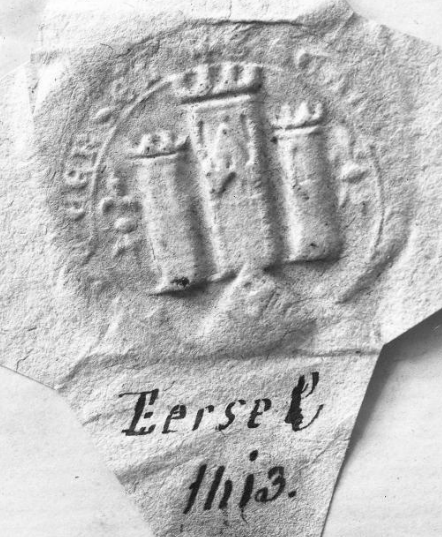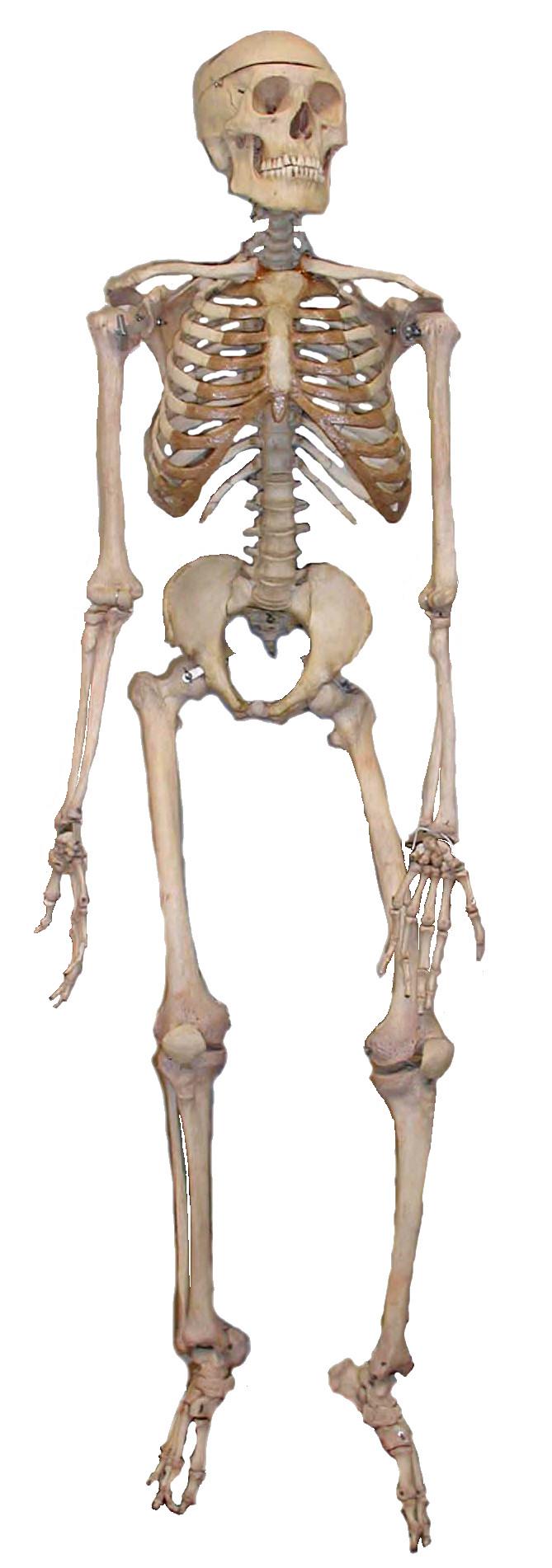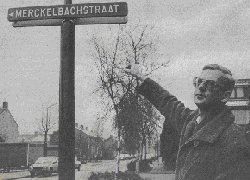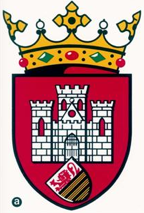 From Merkelbeek to Märckelbach:
From Merkelbeek to Märckelbach:
A Social History with Deep Roots
being cobbled together by Henry K van Eyken
for Elisabeth H., Marc, Elisabeth G., Eric, Adriana, & whomever may come ...
in memory of Adriaan Märckelbach (1896-1965)
|
"There is no peace for the wicked"
Isaiah 48:22 / 57:21 0A
January 20, 2015
Chapter 7. The miser and the brave soldier Jan 2
Eersel,a Dutch town in the province of North-Brabant, sports a coat of arms whose historical origins go back to a seal on a document drawn up in 1339; maybe the very seal shown in the next illustration. The castle, it is said, once belonged to a family named Merkelbach, a family of mixed repute. On the upside, the folk of Eersel like to believe that the Johann Georg von Merckelbach we introduced in Chapter 2, the one who was instrumental in bringing about the 1648 peace treaty of Münster was a descendant of this family. But on the downside, the last Merckelbach inhabiting the castle was one miserable miser who locked his daughter away in one of the castle's towers, leaving her there to starve to death. With a bit of imagination you yourself might be able to make her out in that picture. Now, why did he do such dirty a deed? It seems that she annoyed him greatly. At one time, she reproached him for chasing a pilgrim off his property and, maybe even worse, she fell in love with the son of Count Hendrick van Eyck. There was bad blood between the count's family and the Merckelbachs; she should have known better! 3
 Seal of Eersel, kept in a North-Brabant's historical archive. ( Source). 4
The story of a castle inhabited by Merckelbachs is found in an 1825 manuscript of a regional history written by an A.C. Brock. Agricultural development has since obliterated all obvious evidence of the structure, but in the author's days, the moats were still visible. Moreover, a cadastral map from 1832 indicates that a building with features supporting the presence of towers existed. All of which gave rise to a legend much embellished by a C. Rijken in his 1921 book about myths and legends. Here goes: 5
If one takes the dirt road from Eersel's center, go past the so-called "Drietip"* and on to the hamlet Dalem near Hapert, you'll come by a place called "Court" where centuries past stood a castle that had belonged to a certain family Merckelbach. Descendants are still found in St-Oedenrode and in Belgium. The road's name is "De Eerselse Dijk." Moats partially filled and hazel bushes mark the spot where the castle once was. 6
Near the close of the seventeenth and beginning of the eighteenth century, the castle stood empty, abandoned for it was haunted. Not a soul could summon up enough courage to come near it. Even wary travellers looking for a place to rest overnight passed it by. Except for Jan. For twenty-seven years he had served in the armies of the French king Louis XIV, the "Sun King." He had been on may campaigns and fought in many a battle. Not the kind of man easily scared off by some rumor about ghosts. And so, one evening, he went for a night's stay in the castle. 7
It was a cold, cold autumn evening. The wind howled through the branches of the trees and a driving rain lashed his face. Jan was glad when finally he arrived at the castle where he found the door open, an invitation to enter. So he did and sat himself down near the hearth where he found some logs waiting for a fire to be lit. Moments later, flames merrily flickered their merry dance and Jan could comfortably bask in their warmth. His clothes nearly dry, Jan began making pancakes with the flour and milk he had taken along on this adventure, all the time waiting for things he hoped would happen. "I don't like to have come here all the way for nothing," he protested to himself. 8
When the first pancake was done, there was a sudden thud; a human legbone had fallen from the chimney into Jan's frying pan; a clear bone without any flesh left on it. Jan threw both bone and pancake into a corner of the room, then calmly went on baking. When the second pancake was barely done, kaplunk! another legbone fell in the pan and, again, Jan threw it and the pancake into that same corner. On it went, one bone after the other—armbones, ribs, and, finally, a skull. While frying his seventh pancake, he cast a sideways glance at the the heap of bones and noticed they began to move, slowly arranging themselves to form an upright skeleton. 9
 "Please, Jan, take those treasures! Then I may finally rest in peace!" ( Source). 10
"Hey, thou Grim Reaper," cried Jan, "lust thou a pancake?" but he skeleton didn't answer and Jan, ticked off, threw pancake and frying pan in the spook's face muttering, "Hey, if you can't speak I shall teach you to dance." At that very moment, a bell tower near Duizel struck twelve and the skeleton, rattling and clanking, moved toward our brave soldier Jan. "Open it!" the skeleton commanded, pointing to the door of a cellar. "Why don't you do it yourself," Jan replied, "or are you too lazy?" The bony spook obeyed, then barked a second order, "Go down those stairs!" "You go down yourself!" Jan shot back and, again, the spook obeyed. Curious, Jan followed him. 11
Once in the cellar, the spook pointed to a heavy, blue floor tile and ordered John to lift it. Again, Jan refused, saying: "Don't bother me and pull it up yourself." The spook did as he was told and, lo and behold, underneath the heavy tile Jan saw three boxes filled to the brim with gold. "You see," said the ghost, "When I was still alive, all that gold belonged to me. But I never used any of it to help others. I was fated, therefore, to burn every night; until, that is, I would find someone willing to put all that treasure to good use. Take those boxes, Jan. One you may keep for yourself, the second should be given to the poor, and the third is for the Church." The spook then vanished to not ever come back. 12
John returned to his home safely, heavily laden with treasure. And now he also believed in ghosts. 13
Bibliography
Principal literature of which original copies consulted:
De Eerse Legende, a story about Rudolf Merkelbach's research into an Eersel legend
The references that follow are variations of the Eersel legend or some aspect of it:
Doolgeesten, in Dutch Folktales Bank
Pannenkoeken, in Dutch Folktales Bank
Het verdwenen kasteel, in Dutch Folktales Bank
untitled, in Dutch Folktales Bank
De verborgen schat, in Dutch Folktales Bank
untitled, in Dutch Folktales Bank 14
|
|
|
|
Kernels of truth
Trying to untangle words like "myth" and "legend" 15
Going back to the 1825 MS by A.C. Brock, I quote, "be it a stronghold or a fortified castle, certain it is that once there was a dwelling owned by the family Van Merckelbach, of whom remain descendants here as well as elsewhere, especially noteworthy among them is Joannis Georgius van Merckelbach, counsel to Prince Frederik Margrave of Baden and Hochbergen and his delegate to the Peace of Münster. The family still possesses a printed image showing a portret and coat of arms which is presently located in St. Ode Rode." 15A
 Rudolf Merckelbach points to the streetsign "Merckelbachstraat." ( Source). 15B
In 1966, Eersel's town council, after commissioning historian A.D. Kabeke with a thorough research into the matter, named a street in honor of this illustrius Merckelbach, who, it was assumed, was born in the Court of Eersel. Bear in mind that this peace treaty is a major event in Dutch history for it established the independence from the Spanish monarchy of the Seven United Provinces' of the Netherlands, a.k.a. the Dutch Republic. 15C
Family researcher Rudolf Merkelbach seriously doubt that the Von Merckelbac in question was born in Eersel. Many a Markelbach and Merckelbach were born and lived in Eersel, afstammelingen van Gregorius (Goris) Mar(c)kelbach who himself came from Tienen and after stays in Antwerpen and Rotterdam came to live in Eersel. In 1670, he married Petronilla (Perijn) Joannes Huijsmans who was baptized in Eersel in 1950. Additional details can be found here. Furthermore, we learned that Joannis Georgius was born in Speyer, in present-day Germany. But don't try to tell that in Eersel! 15D
And so, we have a story of a stronghold or fortified castle in Eersel, which appears to be correct; we have a story dating back to 1825 that it was the abode of a Merckelbach family, which may or may not be correct; finally we have a legend, much spun out by a Rijkers in a book from 1921. With these givens, is our legend truly a legend? And what is a legend anyway? In this instance, that is not a question that should give us sleepless nights, but when it comes to finding out why we think what we think it strikes me as an important question. Whether I am right or not will, I expect, come out as our story keeps unfolding. 15E
Myths, legends and folktales are hard to classify and often overlap. Imagine a continuum as illustrated below. On the left, we have an historical account; on the right, myths or cultural folktales. Moving from left to right, the significance of the story is less and less with facts, more and more with what it symbolizes or how people feel about it. By the time you reach the far end of the spectrum, the story has taken on a life of its own; the facts of the original event, if ever there were any, have become pretty well irrelevant. It is the message that counts. 15F
The rational, sceptical mind likes to think of itself as being at the extreme left, a mindset that would be devoid of meaning. A spiritual mind, if it still wishes to be of this world, better stay clear from the extreme right. (A political mind would prefer ths diagram to be turned around.) It seems that Einstein was right again when he said that science without religion is lame, religion without science is blind. 15H
I tried to zero in on just what precisely legends are and myth are, what distinguished a legend from a myth. Naively, I expected to find answers in dictionaries and on the internet. And, yes, I got a fistfull of them, but, and it shouldn't have surprised me, they were imprecise and even somewhat at loggerheads. Let's turn to myths first. A myth, we are told by one website, "is a story based on tradition or legend, which has a deep symbolic meaning. A myth "conveys a truth" to those who tell it and hear it, rather than necessarily recording a true event. Although some myths can be accounts of actual events, they have become transformed by symbolic meaning or shifted in time or place. Myths are often used to explain universal and local beginnings and involve supernatural beings. The great power of the meaning of these stories, to the culture in which they developed, is a major reason why they survive as long as they do—sometimes for thousands of years." Another site is more elaborate: "People have always asked questions like “How did our world come to be?” or “Why do tornadoes happen?” Some myths answered these questions.
In other myths, gods or “super-beings” used their powers to make events happen. Or the stories were the adventures of gods, goddesses, men and women. These myths described the big things that happened to people and the choices they made. They might be about triumph (achieving something), tragedy (losing something), honour (doing the right thing), being brave even when you are frightened, or being foolish and making mistakes. People might be heroes in these stories and gods and goddesses could use their powers to help them or make things more difficult for them. Around the world, myths were shared by groups of people and became part of their culture. Storytellers have passed the stories on from generation to generation and through families. Some myths are told in many cultures, but with variations in the events or characters. For example, most cultures, tribes or groups of people have their version of how our world came to be. For early people, myths were like science because they explained how natural events work. Today we don’t always know if myths are true or not. Some of the stories or characters may seem impossible, and science gives us different explanations for some of our questions. But people all over the world still like to read myths and we all like to think about what they might mean." 15I
Great. Now on the legends. One site: "A legend is a semi-true story, which has been passed on from person-to-person and has important meaning or symbolism for the culture in which it originates. A legend usually includes an element of truth, or is based on historic facts, but with 'mythical qualities'. Legends usually involve heroic characters or fantastic places and often encompass the spiritual beliefs of the culture in which they originate." On to another: "Legends are also stories that have been made up, but they are different from myths. Myths answer questions about how the natural world works, and are set in a time long-ago, before history was written. Legends are about people and their actions or deeds. The people lived in more recent times and are mentioned in history. The stories are told for a purpose and are based on facts, but they are not completely true. Either the person never really did what the story says, or the historical events were changed. The purpose was to make the story more interesting or convincing, or to teach a lesson, like knowing right from wrong." 15J
You see, there is much overlap. Trying to tell myths apart from legends is like trying to tell blue apart from green. There is a continuum. Legends being in the middle of our line are in the left side closer to facts, on the right side closer to myths. The line shouls not really have been blocked out as shown for the transitions are gradual. 15K
Turn back, if you will, to the first paragraph following the diagram. I made a little shift away from telling stories into our thinking more generally, putting the workings of the mind more generally on the same line. Without saying so explicitly, I likened
factual historical accounts to rational or sceptic thinking. And I likened mythical event or folktale based on cultural truth to a spiritual mindset. Now, just what should I liken legends to? In the more general sense I liken them to our fantasies, our everyday conversation, our dreams even. All these have kernels of factual truth and scoops of stuff that is not factually true, but serves other personal needs—to persuade perhaps, to make ourselves grander than we are, to massage our feelings, try to appease somebody or get one riled up, what have you. That diagram dished up as a line really should be likened to a pipeline inside which our minds are in turmoil more or less, jumping hither and thither. I daresay that even consumate sceptics as well as the saintly souls among us spent most of their lives far from the ends of that diagram. 15L
I hope, dear reader, you will these paragraphs some thought and remember them when following me on my quest to try to figure out why we think what we think. In the meantime, I'll leave it to you whether the story of the miser and the brave soldier Jan is a legend or a myth. Or whether it matters a tinker's damn. 15M
|
|
Footnotes
"Drietip." a name that at first was meaningless to me. But after reading a Wikipedia article about Eersel (here), I think I've got it. It would be "Threetips" in English, indicating a triangular court with farms bordering on each side. Quoting from that piece: "The Franks established themselves round 700 again in the region. They lived where high and lower grounds were laying close to each other. One of those high grounds was Ereslo. As from this time there is a form of government authority in this area. The Franks build their farms around a triangular square. This kind of settlement was called a domain which was the property of the high nobility of the Franks." * fn1
|


 Seal of Eersel, kept in a North-Brabant's historical archive. (
Seal of Eersel, kept in a North-Brabant's historical archive. ( "Please, Jan, take those treasures! Then I may finally rest in peace!" (
"Please, Jan, take those treasures! Then I may finally rest in peace!" ( Rudolf Merckelbach points to the streetsign "Merckelbachstraat." (
Rudolf Merckelbach points to the streetsign "Merckelbachstraat." ( From factual truth to spiritual truth (
From factual truth to spiritual truth (